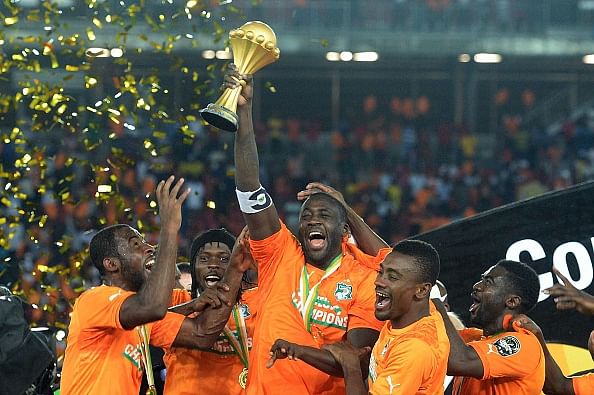
How Herve Renard inspired Ivory Coast to the African Cup of Nations title
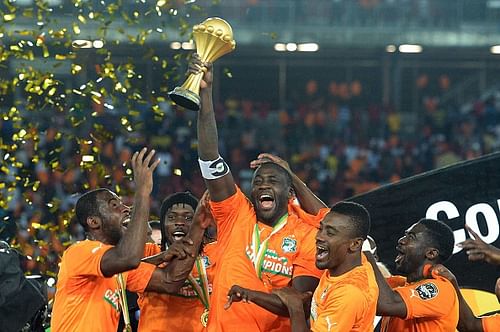
Tournaments tend to be judged less by the quality of their football than by the quality of their stories, and in that regard this Cup of Nations ended up scoring highly. There was the implausible rehabilitation of Boubacar Barry, the trouble at the second semi-final, DR Congo’s brilliant comeback in the quarter-final against Congo and the controversy of Equatorial Guinea’s win over Tunisia in their quarter-final meeting. This is a tournament that will be remembered, although perhaps not for the quality of its football.
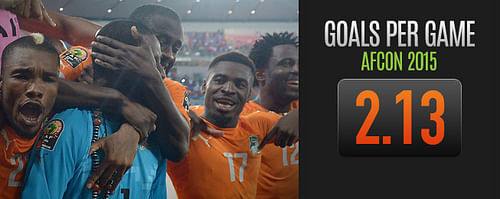
Since Zambia’s success in 2012 – the beginning of the Hervé Renard revolution – the influence of individuals has waned, and there has been a general recognition that what wins tournaments is the strength and discipline of the team unit. That perhaps explains the relatively low number of goals – just 2.13 per game, although that figure wasn’t helped by the poor pitches in Mongomo and Ebebiyin, which, laid only a fortnight before the tournament began, struggled to live up to the strain.
Even before Barry made himself the hero of the final, this had been a good tournament for goalkeepers; the days when African goalkeepers were the subject of mockery is long gone. The best goalkeeper on the continent, Vincent Enyeama, wasn’t even there after Nigeria failed to qualify, but Sylvain Gbohouo, Razak Braimah and the veteran Robert Kidiaba, still doing his bottom-bouncing celebration, all performed well. The pick of the keepers, though, was Felipe Ovono, the 21-year-old Equatorial Guinea keeper who surely won’t be at Deportivo Mongomo much longer after making it into WhoScored's team of the tournament with a rating of 7.19.
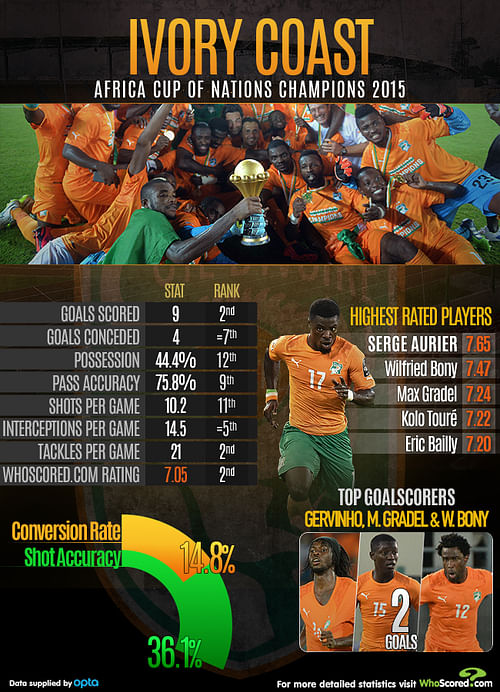
It was a good tournament too for tall, powerful central defenders. Ivory Coast, as well as Kolo Touré who made a colossal 36 clearances at the tournament, have a fine young pairing in Eric Bailly and Wilfried Kanon, who look likely to form the heart of the side for years to come. Both, significantly, showed great calm in converting their penalties in the shoot-out in the final. Kara Mbodj (7.72) of Senegal, who scored one towering goal against South Africa and John Boye (7.77) of Ghana came out on top in the Whoscored rankings to take the central defensive positions in the team of the tournament.
Serge Aurier, after a dismal opening game against Guinea, was excellent in a right midfield role, offering both attacking thrust and defensive cover. On the left, Baba Rahman was similarly keen to take the initiative.
Where this tournament disappointed was in the lack of real creative spark or midfield control. All four midfielders who came high enough in the rankings to make the team of the tournament are of a similar type; players who play at the front of midfield but don’t necessarily control games or set the tempo.
The dearth of playmakers in the region continues to be felt and, perhaps surprisingly, this wasn’t even a great tournament for defensive midfielders. Wakaso Mubarak, who completed the third-most passes at the tournament (173) behind Yaya Touré (240) and Chancel Mangulu (192), developed as the tournament went on, and was excellent in the semi-final with his quick passes out to the right for Christian Atsu, but only South Africa really played a quick, short-passing game through midfield. It meant that in some ways, Shakes Mashaba’s side was the best to watch in the tournament; their problem was that they couldn’t ally that ability with a defensive resolve.
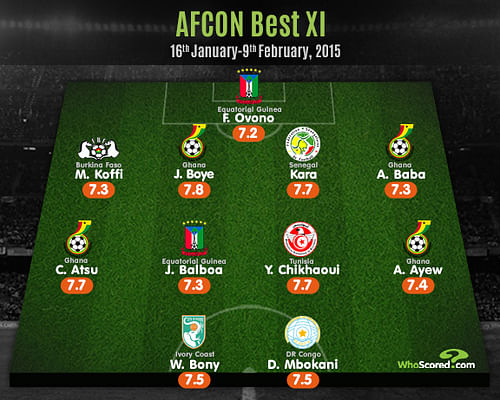
It’s perhaps telling as well of how direct much of the play in the tournament was that the two centre-forwards who scored highest in the rankings are both tall, powerful target-man types, in Dieumerci Mbokani (7.46) and Wilfried Bony (7.47). Neither was prolific, scoring 3 and 2 goals, respectively, and although Bony's two were key strikes in the quarter-final against Algeria, his main importance was his capacity to hold the ball up for runners form midfield. Mbokani, meanwhile, troubled Ivory Coast in the semi-final, but his best game by far was against Congo in the quarter, when he scored twice from 5 shots in a man of the match performance.
It’s dangerous, always, to draw conclusions from one tournament, but this Cup of Nations suggested that African football is moving away from individualism and that the Renardian philosophy of the team is leading to a lot of muscular, direct football.